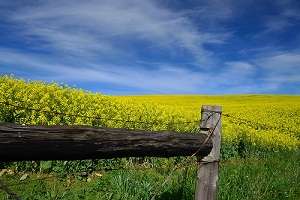Dry seeding examined for Wheatbelt crops

Agronomy scientists have been conducting a series of experiments to help Wheatbelt farmers climate-proof their crops.
Dr Darshan Sharma, a senior Research Officer at Department of Agriculture and Food, says the usual practice of wet-seeding after first rain results in a crop with staggered flowering times.
As most farmers use a single seeder, he says this often causes much of their crops to miss the full benefit of a limited growing season.
Dr Sharma says a Kellerberrin farmers' group prompted the project by asking how much soil moisture would be needed to sow canola early in April, and what level of rainfall would render the crop risk-free.
In the first part of the study, the team is investigating dry-seeding before first rains break.
"If at least a portion of seeding is done before the breaking rain arrives, that proportion of your seeding program starts germinating with the first drop of rain—the first drop of moisture the seed gets," he says.
"But all this advantage comes at a risk," Dr Sharma says.
"This project is basically to look into those risks to minimise those risks and then to provide some guidelines.
"This year what we wanted to see is, if the season starts with early water deficit but later on the season recovers, which happened this year, which crop is better able to compensate for the early deficit?"
In a dry-seeding trial of wheat and canola at Merredin this year, natural rainfall has been boosted by irrigation.
Segregated sections of each crop were irrigated with measured amounts of water to mimic seasons with increasingly higher rainfall.
This should result in a dataset that demonstrates the dry-seeded crops' performance over 30 possible seasons.
"That will tell us, wheat or canola, which one compensates better for early water deficit when the deficit recovers in July," he says.
Dr Sharma says a longer growing season attracts greater susceptibility to other natural events such as heatwaves and frost.
He says when you dry sow, the whole crop tends to germinate at the same time, and to flower on the same day.
"If you get a frost, all that is flowering on the day is in the sensitive phase—all that's killed."
Dr Sharma says the experiment is still undergoing its first trial, which will produce data later this year.
"When we have interrogated that data after we harvest we should be able to put in some rule of the thumb," he says.
Provided by Science Network WA

















